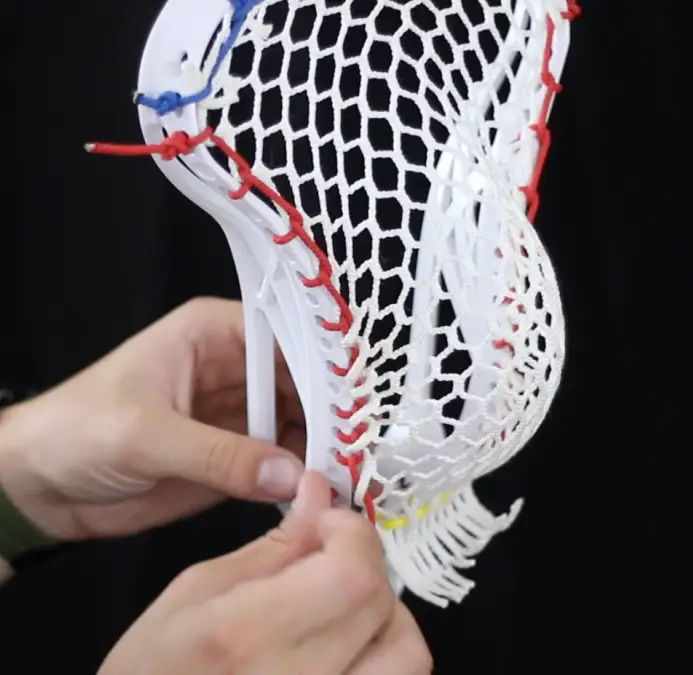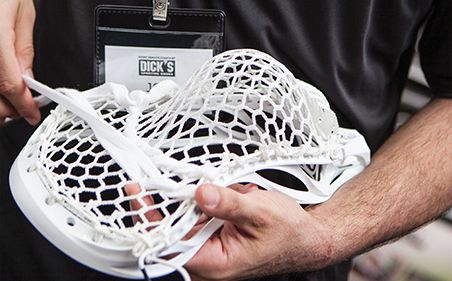In 2020, a few rule changes were made to both high school (NFHS) and college lacrosse (NCAA). One of the most important ones you must know is about stringing, particularly how deep can a lacrosse pocket be. Having the wrong pocket depth directly impacts your eligibility to play the game. So if you aren’t sure how deep a lacrosse pocket should be, continue reading to find out everything you need to know.
In a nutshell, your lacrosse pocket shouldn’t be deeper than one lacrosse ball to pass the legality test before every game starts. In other words, there should not be any gap between the lacrosse head and the ball. Another way to make sure your pocket isn’t too deep is to hold the pocket near your eye level, if you can’t see the entire ball it’s good. For goalies, make sure your pocket is between two and four balls deep.
In order to find that sweet spot that both keeps the pocket legal and maintains the best hold, it requires some trial and error to figure out the ideal pocket depth. So we are going to talk about stringing as well later in the post. Without further ado, let’s jump in.
Read also: What you need to know about shooting strings
Legal Pocket Rules
Field Players
First and foremost, let’s take a look at the rules to understand what’s a perfect pocket depth. As I mentioned before in the blog, many regulations and rules we have around the game are in place to promote a more level playing field for both defense and offense players. If we don’t place restrictions on the depth of the pocket, it’s nearly impossible for defenders to knock off the ball. There’s the saying, whoever wins possession wins the game. The rule-makers are actively trying to change this dynamic to make lacrosse more competitive and entertaining.

The exact rule states, “The top of a lacrosse ball must be at least a little bit above the bottom edge of the sidewall. The pocket is illegal if the top of the ball is below the bottom edge of the sidewall.” In other words, your pocket shouldn’t sag too deep in any way. Note this rule applies to both male and female lacrosse players.
Do this quick test to check if your pocket is too deep. Hold your stick perpendicular to the ground and slowly turn it 90 degrees forward to see if the ball falls out. And repeat the same motion in the opposite direction but horizontally. If the ball falls out, it’s at a legal depth. If it doesn’t the pocket is too deep. Time to shrink up the depth to make it shallower.
Goalies
For goalies, you will have more freedom in regard to making it shallower or deeper to your liking. There are no written restrictions on a goalie’s pocket depth. Normally when we say a shallow pocket it’s 1-2 ball of depth. When we say a deep pocket it’s 4 balls of depth.
So if there are no limits on how deep the pocket needs to be, can the goalies make it infinitely deep to maintain control? Well there are tradeoffs.
A deeper pocket is more favorable when making a save. It’s better at absorbing velocity and can retain the ball better without letting it rebound. Plus, having a deeper pocket helps a lot with retention as the ball sits inside the channel. In contrast, when making a save with a shallow pocket, the ball is likely to bounce off the net. Also, a shallow pocket makes it very easy to pop off the pocket when cradling.
But a shallow pocket is better at making more accurate and longer passes. As a goalie, you are often given the opportunities to throw outlets. With a shallow pocket, it’s way easier to accurately feed an open middie that is waiting for the fast break opportunity.

Therefore, considering all these factors, it’s common to see goalies carrying pockets between 2 to 4 balls deep. And anywhere between this range is up to the goalie’s preference and their lacrosse sticks.
Pros and Cons of Deep and Shallow Pockets
So as long as your pocket is no deeper than a ball of depth you will be legal to play. And of course, there are more nuances that go into the exact depth you can choose, either shallow or deep. To help you make an easier decision, you can refer to the pros and cons below to determine which option suits your preference more.
Deep Pockets:
Pros:
- Best ball retention
- Easier to catch
- Better shooting power
Cons:
- Risk of being deemed illegal
- Slower shooting release
- Slower ball release
Because the pros outweigh the cons when it comes to possession, it’s common to see players go for the deepest possible pocket within the legal limit. The ball is buried deeper into the pocket so it’s harder for the opponent to create a turnover opportunity.
That said, one thing to keep in mind is your release will be slower. It requires more power to push the ball out of the pocket and travel to the aiming target. So after stringing a deep pocket, take some time getting adjusted to it.
Shallow Pockets:
Pros:
- Very safe to play
- Fast shooting release
- Fast shot release
Cons:
- Less ball control
- Harder to catch passes
- Less shooting power
With a shallow pocket, you don’t need to worry about legality issues. Since you will sacrifice some ball control and retention, rarely do players make their pockets super shallow. Shallow pockets do allow you to make fast and quick shots. If you are a player who enjoys the ability to pass or shoot quickly, shallow pockets will help you achieve that. In addition, you don’t need to put too much power into your shots for quick releases.

Now you should take some time experimenting with these pockets to find out which one is the best for your liking. But to do that, you need to know how to adjust your pocket. So the next section will be all about finding the perfect pocket for your stick.
Read also: Best Lacrosse Mesh In 2022
How To Adjust A Perfect Pockets
There are a couple ways you are able to adjust the depth of your pocket. We will go over them right now.
Pound the pocket & Adjusting the bottom strings
If you just bought some new mesh, it will be very tight at first. What you can do is pound the pocket to let it stretch out. A couple of ways players do include using a lacrosse ball, tennis ball, the butt end of your stick, or what I recommend players use, a pocket pounder.
To deepen the pocket, you want to give the bottom string a little slack so it becomes looser than it originally was. Untie the bottom string knots, introduce a bit of slack, and then retie the knots. Inversely, to make the pocket shallower, you will do instead tighten up the bottom string. The same motion but this time you will pull the strings a little to make them tighter. You only need to adjust for a tiny bit so be gentle and settle with your motions.
Adjusting the sidewall strings
Another popular way to adjust your pocket is to adjust the sidewall strings. A disclaimer is I was never an expert in stringing pockets, so I might not be the best person to educate you on how to alter the knots pattern on the sidewall strings. So I included some videos done by Greg from ECD for your reference.
To create a deeper pocket, you want to bunch the mesh diamonds together at one location with a few knots on the sidewall to make them tighter. Inversely, to create a shallower pocket, you want to spread out the mesh diamonds and tie each of them to the sidewall with knots. In other words, the idea is to consolidate mesh diamonds when needing a deeper pocket or spread out mesh diamonds when needing a shallower pocket.
To further understand this concept, let’s see what Greg has to say:
In conclusion
To wrap up the discussion, there are two key takeaways I want to remind you of. First, you must keep your pocket within the legal limit. Then it’s up to your preference and playing style to find out the best pocket depth for your pocket.
So before doing anything else, first determine what pocket depth you are looking for. Depending on whether you need to deepen or tighten the pocket, utilize different strategies. If you aren’t yet comfortable with stringing, feel free to ask a teammate or your coach to give you a hand.
Read also: 5 Best Things To Do Before The Tryout Day




